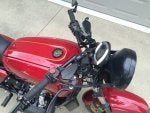Many have asked me to help with changing from a conventional axial front master cylinder (MC) to a radial, and in trying to give accurate information I came up with the following spreadsheet to help determine what piston size radial MC would be appropriate. The reason why there is so much confusion is the basic setups of the two types are quite a bit different: the axial units typically use a smaller piston size than the radials, and a lower mechanical leverage ratio at the lever than radials.
For example, my 2002 Honda 919 with stock master has a 14mm piston and the lever pivot to piston distance is 25mm, while the pivot to hand distance is ~ 90mm (When divided it is called the interaxis ratio). When the total area of all eight caliper pistons (30.15mm and 27mm) is divided by the area of the MC bore it gives a hydraulic ratio of 33.429:1, which when multiplied by the interaxis ratio produces an overall leverage ratio of 120.34:1. This is on the low side of typical for modern sintered brake pads. When I decided to switch to a radial MC for a variety of reasons, not the least of which being a desire for a slightly higher ratio for less effort at the lever and a wider engagement band to make holding the brake just this side of locking easier, I crunched the numbers for an overall ratio of ~130 - 135:1, and came up with a MC bore size of 17.5mm (actually it's 11/16ths, or 17.4625mm). Fortunately this is a size used by all years of the CBR1000, and a couple of Kawasakis. Installation of a MC obtained from a seller on EBAY confirmed the validity of the calculation -- slightly decreased lever effort, and better control near locking up.
On the subject of what ratio is desirable, and what to do if the ratio you want does not match up to an available master cylinder piston diameter: shoot for the next larger size piston and adjust the ratio using the only other parameter available to you -- the Master cylinder lever pivot to finger distance. For an example the numbers on the spreadsheet are for my 919. Change the master cylinder piston diameter to 18mm then go down to the pivot to finger parameter and change it until the overall ratio matches. Once you know approximately where to mount up the master cylinder it is easy to vary the feel on the road (well, parked next to the road) by moving the MC toward or away from the throttle.
Another factor to take into account is the coefficient of friction of the brake pads. Pad manufacturers do not make this information available for obvious reasons, so you have to go by feel here. If you are running brand X pads and like the feel they give with the stock MC enter the appropriate numbers in the spreadsheet for your system to get the stock ratio, then change the interaxis pivot to piston / pivot to finger and piston diameter numbers for the MC you want to run. If, however, the pads are too sensitive or "grabby", decrease the stock ratio by about 5% to start. Conversely, if they have adequate power but take too much effort at the lever increase the ratio by 5%. Then vary the pivot to finger number to obtain the desired ratio. You get the idea.
FYI: The typical range of ratios for modern brakes are from ~115:1 to 145:1 or a little more. Lower than 115 will give a lever that pulls back a short distance then feels rock hard, but takes too much effort at the lever to stop. Higher than 145 to 150 will take more lever travel to engage the brakes, but will require less force at the lever, usually feeling too sensitive when braking.
The spreadsheet: written in MS works, will also open in Excel.
It will work for up to 6 pistons. It will also work for single acting calipers as while there are pistons on only one side, the rear wall of the bore the pistons operate in acts as a second piston, moving the entire caliper body to apply force to the inside pads. They are calculated in the same manner as double acting calipers.
Link: Master cylinder calculator updated 4 Mar 2021.xlr
Rob
For example, my 2002 Honda 919 with stock master has a 14mm piston and the lever pivot to piston distance is 25mm, while the pivot to hand distance is ~ 90mm (When divided it is called the interaxis ratio). When the total area of all eight caliper pistons (30.15mm and 27mm) is divided by the area of the MC bore it gives a hydraulic ratio of 33.429:1, which when multiplied by the interaxis ratio produces an overall leverage ratio of 120.34:1. This is on the low side of typical for modern sintered brake pads. When I decided to switch to a radial MC for a variety of reasons, not the least of which being a desire for a slightly higher ratio for less effort at the lever and a wider engagement band to make holding the brake just this side of locking easier, I crunched the numbers for an overall ratio of ~130 - 135:1, and came up with a MC bore size of 17.5mm (actually it's 11/16ths, or 17.4625mm). Fortunately this is a size used by all years of the CBR1000, and a couple of Kawasakis. Installation of a MC obtained from a seller on EBAY confirmed the validity of the calculation -- slightly decreased lever effort, and better control near locking up.
On the subject of what ratio is desirable, and what to do if the ratio you want does not match up to an available master cylinder piston diameter: shoot for the next larger size piston and adjust the ratio using the only other parameter available to you -- the Master cylinder lever pivot to finger distance. For an example the numbers on the spreadsheet are for my 919. Change the master cylinder piston diameter to 18mm then go down to the pivot to finger parameter and change it until the overall ratio matches. Once you know approximately where to mount up the master cylinder it is easy to vary the feel on the road (well, parked next to the road) by moving the MC toward or away from the throttle.
Another factor to take into account is the coefficient of friction of the brake pads. Pad manufacturers do not make this information available for obvious reasons, so you have to go by feel here. If you are running brand X pads and like the feel they give with the stock MC enter the appropriate numbers in the spreadsheet for your system to get the stock ratio, then change the interaxis pivot to piston / pivot to finger and piston diameter numbers for the MC you want to run. If, however, the pads are too sensitive or "grabby", decrease the stock ratio by about 5% to start. Conversely, if they have adequate power but take too much effort at the lever increase the ratio by 5%. Then vary the pivot to finger number to obtain the desired ratio. You get the idea.
FYI: The typical range of ratios for modern brakes are from ~115:1 to 145:1 or a little more. Lower than 115 will give a lever that pulls back a short distance then feels rock hard, but takes too much effort at the lever to stop. Higher than 145 to 150 will take more lever travel to engage the brakes, but will require less force at the lever, usually feeling too sensitive when braking.
The spreadsheet: written in MS works, will also open in Excel.
It will work for up to 6 pistons. It will also work for single acting calipers as while there are pistons on only one side, the rear wall of the bore the pistons operate in acts as a second piston, moving the entire caliper body to apply force to the inside pads. They are calculated in the same manner as double acting calipers.
Link: Master cylinder calculator updated 4 Mar 2021.xlr
Rob







